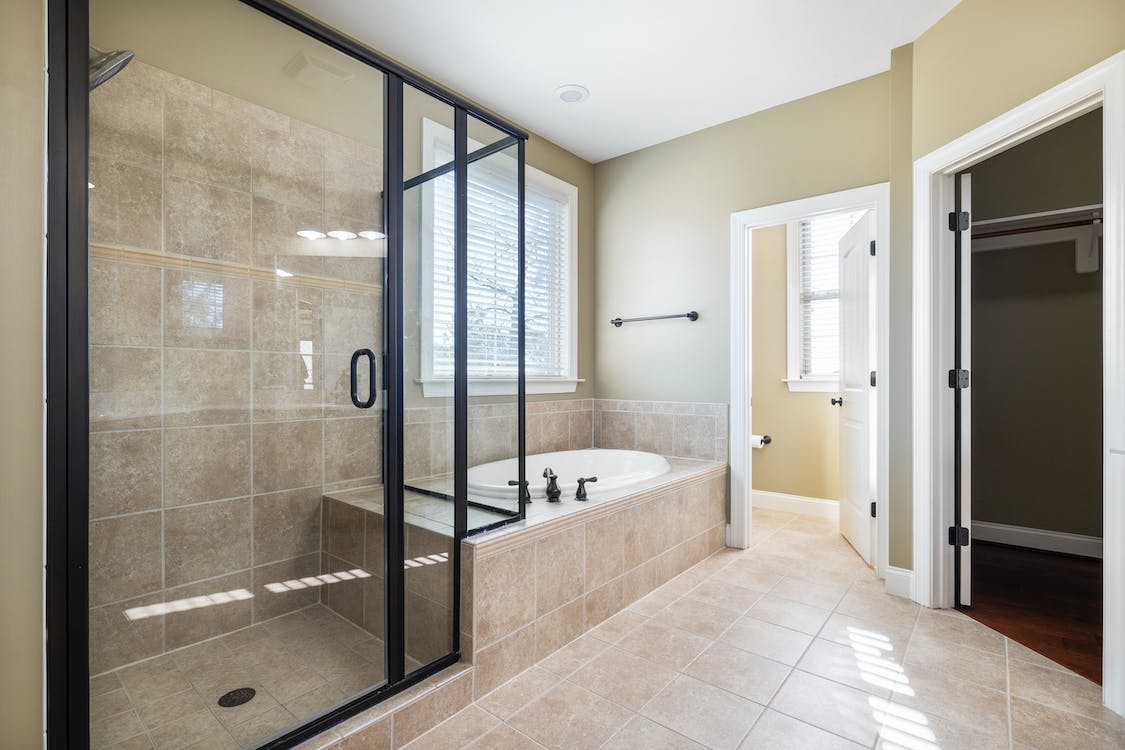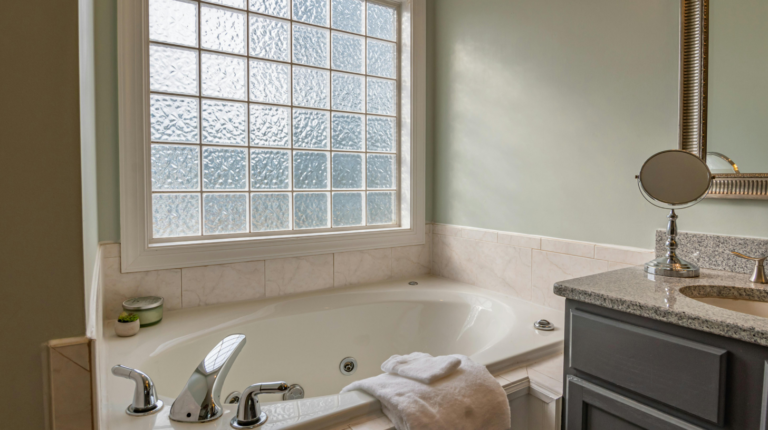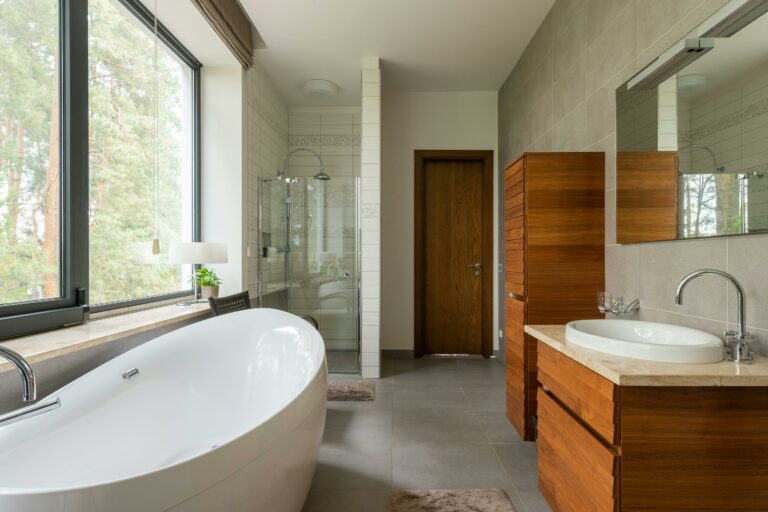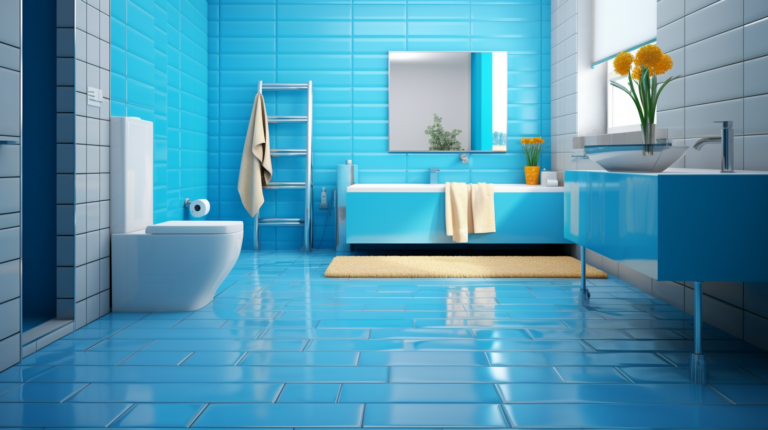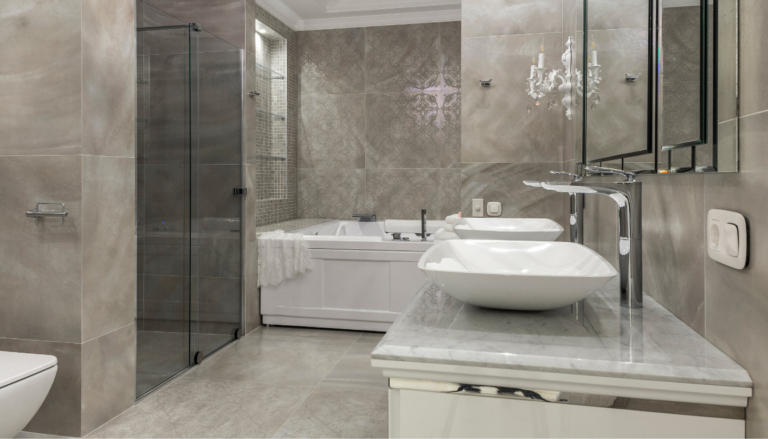Accessible Bathroom Design : Tips for Homeowners with Disabilities in 2024
Welcome, homeowners! In this article “Accessible Bathroom Design : Tips for Homeowners with Disabilities in 2024”, we are going to dive into the world of accessible bathroom design. Whether you or a loved one has a disability or you simply want to create a space that is safe and convenient for everyone, understanding the principles of accessible bathroom design is essential.
Having a bathroom that is accessible to all is more important than ever. As the population continues to age, the demand for accessible features in homes is rapidly growing. In fact, less than 5% of homes in the United States have the necessary features to accommodate people with physical disabilities.
In this article, we will explore the concept of universal design bathrooms, the cost of remodeling for accessibility, the integration of smart technology, the requirements outlined by the Americans with Disabilities Act (ADA), and the essential elements of an accessible bathroom. By the end, you’ll have a wealth of knowledge to help you transform your bathroom into a safe and accessible space for all.
So, let’s get started by understanding the concept of universal design bathrooms and why they are so important in today’s world.
Table of Contents
- 1 Understanding Universal Design Bathrooms
- 2 Cost of Remodeling a Bathroom for Accessibility
- 3 Smart Technology in Accessible Bathroom Design
- 4 ADA Requirements for an Accessible Bathroom
- 5 Elements of an Accessible Bathroom
- 6 Conclusion: The Benefits of a Well-Designed Accessible Bathroom
- 7 Frequently Asked Questions
Understanding Universal Design Bathrooms

Welcome to the first section of our article on accessible bathroom design! In this section, we will explore the concept of Universal Design Bathrooms and why they are important for homeowners with disabilities. So let’s dive in!
What is a Universal Design Bathroom?
A Universal Design Bathroom is a bathroom that is designed to be accessible and usable by everyone, regardless of age or ability. It focuses on creating a space that is safe, comfortable, and easy to use for people with disabilities or mobility challenges. The goal of a Universal Design Bathroom is to promote independence and inclusion for all individuals.
Need for Universal Design Bathrooms
The need for Universal Design Bathrooms has never been more important. Here are a couple of reasons why:
-
- Growing aging population: The percentage of the population above 65 years is growing at a rapid rate. As people age, they may face mobility challenges or disabilities that require accessible bathroom features. Universal Design Bathrooms can help them maintain their independence and quality of life.
“By 2050, the number of people aged 65 and older is projected to reach 1.6 billion worldwide.”
-
- Limited accessibility in homes: Surprisingly, less than 5% of US homes have the necessary features to accommodate people with physical disabilities. This lack of accessibility in homes can restrict the freedom and mobility of individuals with disabilities. Universal Design Bathrooms can address this issue by providing accessible features that make daily routines easier.
“Making homes accessible benefits everyone, not just people with disabilities.”
By incorporating Universal Design principles in bathroom remodeling, homeowners can create a space that is functional, beautiful, and meets the needs of all individuals. So if you or a loved one require accessible features in the bathroom, it’s time to consider Universal Design Bathrooms!
In the next section, we will discuss the cost of remodeling a bathroom for accessibility. So stay tuned!
Cost of Remodeling a Bathroom for Accessibility

Remodeling a bathroom for accessibility can greatly improve the functionality and safety of the space for individuals with disabilities. However, it is important to consider the associated costs before starting such a project. The cost of remodeling a bathroom for accessibility can vary depending on several factors, including the extent of the renovations and the specific needs of the homeowner.
Here are some key points to keep in mind when considering the cost of remodeling a bathroom for accessibility:
- Budget Range: The cost of remodeling a bathroom for accessibility can range from $100 to $15,000 or more. The final cost will depend on the scope of the project and the materials used. It is important to establish a budget range before starting the remodeling process.
- Assessment and Planning: A professional assessment of the existing bathroom is crucial to determine the necessary modifications and improvements. This assessment will help identify areas where accessibility features can be incorporated.
- Structural Changes: If the existing bathroom layout needs to be modified to accommodate accessibility features, such as widening doors or rerouting plumbing, the cost of remodeling may be higher. Structural changes often require specialized labor and additional materials.
- Accessible Fixtures: Installing accessible fixtures, such as grab bars, shower seats, and handheld showerheads, can increase the cost of remodeling. These fixtures are designed to enhance safety and ease of use for individuals with disabilities.
- Flooring and Surfaces: Non-slip flooring and other modifications to surfaces may be necessary to ensure a safe and accessible bathroom. These modifications can add to the overall cost, depending on the materials chosen.
- Smart Technology Integration: Incorporating smart technology features, such as voice-activated controls or motion-sensor faucets, can add to the cost of remodeling. However, these technologies can greatly enhance accessibility and convenience.
While the cost of remodeling a bathroom for accessibility may seem daunting, it is important to view it as an investment in the long-term comfort and safety of the homeowner. Additionally, there may be financial assistance options available for individuals with disabilities, such as grants or tax credits, which can help offset the cost.
It is recommended to consult with a professional contractor or accessibility specialist to get accurate cost estimates and guidance on specific modifications required for your unique needs. By carefully considering the cost and planning ahead, homeowners can create a bathroom that is both accessible and aesthetically pleasing, improving their quality of life and independence.
Smart Technology in Accessible Bathroom Design

Smart technology integration is a growing trend in accessible bathroom design. With advancements in technology, homeowners with disabilities now have access to a range of innovative solutions that can greatly enhance the functionality and convenience of their bathrooms. In this section, we will explore some of the smart technologies that are making bathrooms more accessible and user-friendly.
Sensor-Activated Fixtures
Sensor-activated fixtures are a game-changer in accessible bathroom design. These fixtures, such as sensor-activated faucets and toilets, eliminate the need for physical contact, making them ideal for individuals with limited mobility or dexterity. By simply waving a hand in front of the sensor, the fixtures are activated, providing a touchless and hygienic experience.
Voice-Activated Controls
Voice-activated controls have become increasingly popular in modern accessible bathrooms. With voice commands, users can control various aspects of the bathroom, such as turning the lights on and off, adjusting the water temperature, and even operating showerheads. This technology is particularly beneficial for individuals with limited mobility or visual impairments, as it provides a hands-free and intuitive way to use the bathroom.
Smart Mirrors
Smart mirrors are another innovative addition to accessible bathroom design. These mirrors come equipped with various features, such as built-in LED lighting, temperature display, and even interactive touch screens. Smart mirrors can also be integrated with voice-activated assistants, allowing users to access weather updates, news, and other helpful information while getting ready in the bathroom.
Automatic Door Openers
For individuals using wheelchairs or mobility aids, navigating through doorways can be challenging. Automatic door openers are designed to address this issue by enabling hands-free operation of the bathroom door. These openers can be activated through sensors or push buttons, making it easier for individuals with limited mobility to enter and exit the bathroom independently.
Home Automation Systems
Home automation systems play a crucial role in creating a seamless and accessible bathroom experience. These systems allow users to control various bathroom features, such as lighting, temperature, and music, through a central hub or smartphone app. This level of control enhances convenience and accessibility for individuals with disabilities, allowing them to personalize their bathroom environment according to their needs and preferences.
With smart technology integration, accessible bathrooms are becoming more user-friendly and inclusive. These technologies not only enhance the functionality of the bathroom but also promote independence, safety, and convenience for individuals with disabilities. Whether it’s sensor-activated fixtures, voice-activated controls, or home automation systems, the possibilities for creating a smart and accessible bathroom are continually expanding.
Remember, when incorporating smart technology into your bathroom design, it’s essential to consider the specific needs and preferences of the individual using the space. Consulting with a professional designer or accessibility expert can help ensure that the technology chosen is suitable and beneficial for the user.
Also Read: Small Bathroom with Big Impact : Space-Saving Tips for Homeowners in 2024.
ADA Requirements for an Accessible Bathroom
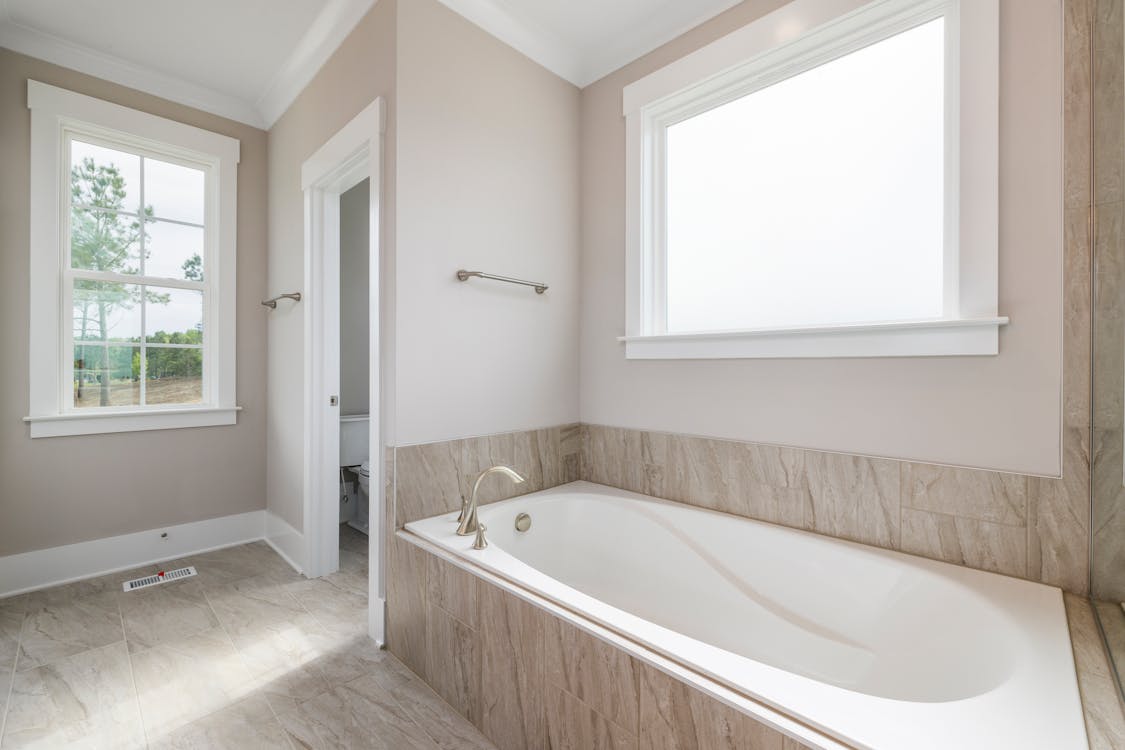
When designing an accessible bathroom, it is important to adhere to the guidelines set by the Americans with Disabilities Act (ADA). These requirements ensure that the bathroom is safe and accessible for individuals with physical disabilities. Here are some of the key ADA requirements for an accessible bathroom:
Turning Radius Requirement
One of the primary considerations in an accessible bathroom design is the turning radius for a wheelchair. The ADA requires a minimum turning radius of 5 feet (60 inches) in a bathroom. This provides enough space for wheelchair users to maneuver comfortably within the bathroom.
Bathroom Space Requirement
In addition to the turning radius requirement, the ADA also outlines recommendations for the overall space in a wheelchair-accessible bathroom. The minimum clear floor space recommended for a wheelchair-accessible bathroom is at least 30 inches by 48 inches. This allows for easy movement and maneuverability for individuals in wheelchairs. It is important to ensure that there are no obstacles or barriers within this space.
It’s worth noting that these are just a few of the ADA requirements for an accessible bathroom. There are additional guidelines regarding door width, grab bar placement, toilet height, and other elements that should be considered when designing an accessible bathroom. It is advisable to consult the ADA guidelines or work with a professional who is familiar with these requirements to ensure compliance and a safe, accessible bathroom.
- ADA requires a minimum turning radius of 5 feet (60 inches) in a bathroom.
- The minimum clear floor space recommended for a wheelchair-accessible bathroom is at least 30 inches by 48 inches.
- Consult the ADA guidelines or work with a professional to ensure compliance and a safe, accessible bathroom.
By following the ADA requirements, you can create a bathroom that is accessible and safe for individuals with disabilities. Providing ample space for wheelchair maneuverability and accommodating the specific needs of individuals with disabilities will enhance the functionality and usability of the bathroom. Creating an accessible bathroom is not just about meeting legal requirements, it is also about promoting inclusivity and ensuring that everyone, regardless of their physical abilities, can use the bathroom with ease and independence.
Remember, accessibility is not limited to individuals with disabilities. A well-designed accessible bathroom benefits everyone. It can be particularly beneficial for seniors who may have mobility challenges or individuals recovering from injuries or surgeries. Investing in an accessible bathroom design can significantly improve the quality of life and independence for individuals with disabilities and offer comfort and convenience to all.
Elements of an Accessible Bathroom

When it comes to designing an accessible bathroom, there are several key elements to consider. These elements are specifically designed to make the bathroom safe and convenient for individuals with disabilities or limited mobility. Whether you or a loved one have a disability or are planning for the future, these features can greatly enhance the accessibility of a bathroom. Let’s take a closer look at some of the important elements of an accessible bathroom:
Non-slip Flooring
Why is it important?
Slippery floors can be hazardous, especially for individuals with mobility issues. Non-slip flooring is essential in preventing accidents and providing stability in the bathroom.
What are the options?
- Textured Tiles: These tiles have a rough surface, offering better traction and grip.
- Vinyl or Rubber Flooring: These materials are naturally slip-resistant and provide a softer surface underfoot.
Widened Doors
Why is it important?
Widened doors allow for easy access to the bathroom, especially for individuals using mobility aids such as wheelchairs or walkers.
What are the considerations?
- Door Width: The door should be wide enough to accommodate the movement of a wheelchair, typically around 36 inches.
- Door Swing: Consider the swing direction of the door to ensure there is ample space for maneuvering.
Grab Bars
Why are they important?
Grab bars provide essential support and stability in the bathroom. They are strategically placed to assist individuals in moving around safely.
What are the options?
- Wall-mounted grab bars: These bars can be installed near the toilet, shower, and bathtub to provide support while sitting, standing, or entering and exiting.
- Floor-to-ceiling grab bars: These bars are ideal for individuals who need additional support in navigating their way around the bathroom.
Curbless Level Entry Showers
Why are they important?
Curbless showers eliminate the need to step over a barrier, making it easier for individuals with mobility challenges to enter and exit the shower safely.
What are the benefits?
- Accessibility: Curbless showers provide a seamless transition into the shower area, ensuring a smooth and barrier-free experience.
- Safety: With no step to navigate, the risk of falls or accidents is significantly reduced.
Handheld Shower Heads
Why are they important?
Handheld shower heads offer flexibility and convenience for individuals with limited mobility. They allow for better control and ease of use during bathing.
What are the advantages?
- Versatility: The handheld shower head can be easily adjusted and directed to the desired position, making bathing more comfortable and accessible.
- Independence: Users can easily control the water flow and direction, reducing the need for assistance during showering.
Safety Rails
Why are they important?
Safety rails play a crucial role in enhancing the safety and stability of an accessible bathroom. They provide support and balance for individuals with limited mobility.
What areas should have safety rails?
- Toilet: Installing safety rails next to the toilet helps individuals with disabilities transfer safely and maintain stability while using the restroom.
- Bathtub and shower: Safety rails can be placed near the bathtub or shower area to offer support and prevent slips and falls.
Remember, when designing an accessible bathroom, it’s important to consult with professionals who are experienced in universal design principles. They can help you customize the elements mentioned above to suit your specific needs and ensure your bathroom is safe and accessible.
Creating an accessible bathroom is not only beneficial for individuals with disabilities but also for seniors who may have mobility challenges. By implementing these essential elements, you can transform your bathroom into a space that promotes independence, safety, and comfort for everyone.
Also Read: Bathroom Makeover : Affordable Updates for a Fresh Look in 2024.
Conclusion: The Benefits of a Well-Designed Accessible Bathroom
Having an accessible bathroom design in your home can bring numerous benefits, not just for individuals with disabilities but for everyone in the household. Here are some key advantages of investing in an accessible bathroom design:
- Safety and Accessibility: An accessible bathroom prioritizes safety and makes it easier for individuals with disabilities or limited mobility to move around and perform daily tasks. It minimizes the risk of accidents and falls, providing peace of mind for both users and their families.
- Increased Independence: An accessible bathroom allows individuals with disabilities to maintain their independence and perform personal care tasks without assistance. It promotes self-confidence and helps individuals maintain their dignity.
- Comfort and Convenience: Accessible bathrooms are designed to accommodate the unique needs and preferences of individuals with disabilities. They often include features such as adjustable fixtures, non-slip flooring, and strategically placed grab bars, providing a more comfortable and convenient experience for users.
- Universal Design: An accessible bathroom design follows the principles of universal design, which means it is usable by everyone, regardless of age or ability. This means that even if you don’t have a disability now, your bathroom will be ready to accommodate any future needs. It also makes your home more appealing to a wider range of potential buyers if you decide to sell.
- Health and Well-being: An accessible bathroom promotes better hygiene and overall well-being. It allows individuals to maintain their personal care routines independently, which can have a positive impact on their physical and mental health.
- Value and Investment: Investing in an accessible bathroom design can increase the value of your home. As the demand for accessible features continues to grow, homes with accessible bathrooms are becoming more desirable in the real estate market.
In conclusion, having a well-designed accessible bathroom is not only essential for individuals with disabilities but also beneficial for their families and the overall functionality of the home. It provides safety, comfort, convenience, and promotes independence and well-being for all users. By considering the principles of universal design and incorporating accessible features, you can create a bathroom that adapts to the changing needs of your family and adds value to your home.
For more related design information and inspiration, read Creating a Minimalist Bathroom : Spa-like Retreat in 2024. Happy Design!!
So, don’t wait any longer – start exploring the options for remodeling your bathroom to make it accessible and enjoy the numerous benefits it brings to your household!
Frequently Asked Questions
- What is an accessible bathroom design?
An accessible bathroom design refers to creating a bathroom layout and features that are specifically designed to accommodate the needs of individuals with disabilities, allowing them to use the bathroom independently and safely. - What are some important tips for accessible bathroom design?Some important tips for accessible bathroom design include installing grab bars, widening doorways and hallways, using non-slip flooring, having a roll-in shower or walk-in bathtub, and providing adequate space for maneuvering mobility devices.
- What are the key features of an accessible bathroom?Key features of an accessible bathroom include grab bars, lever-style faucets, a roll-in shower or walk-in bathtub with adjustable seat, an elevated toilet seat, non-slip flooring, and adequate space for maneuverability with mobility devices.
- Can I make my existing bathroom accessible without a major renovation?Yes, you can make your existing bathroom more accessible without a major renovation. Simple modifications like installing grab bars, adding non-slip flooring, and adjusting the height of the toilet seat can greatly enhance accessibility.
- Are there any specific guidelines or codes to follow for accessible bathroom design?Yes, there are guidelines and codes that provide specific requirements for accessible bathroom design, such as the Americans with Disabilities Act (ADA) in the United States. It’s important to familiarize yourself with these guidelines to ensure compliance and proper accessibility.

